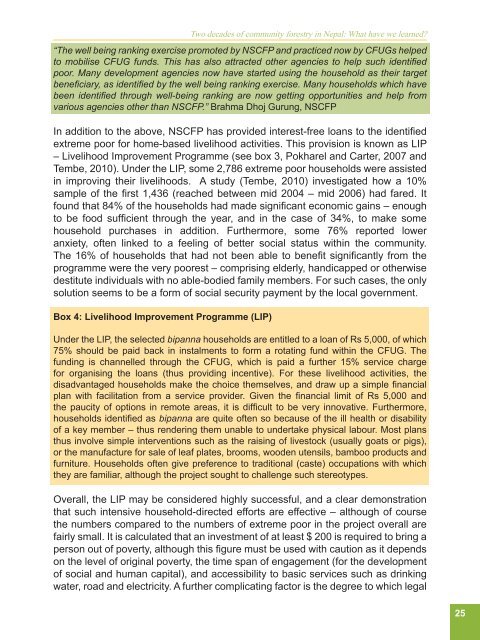Two decades of community forestry in Nepal: What have we learned?
Two decades of community forestry in Nepal: What have we learned?
Two decades of community forestry in Nepal: What have we learned?
Create successful ePaper yourself
Turn your PDF publications into a flip-book with our unique Google optimized e-Paper software.
<strong>Two</strong> <strong>decades</strong> <strong>of</strong> <strong>community</strong> <strong>forestry</strong> <strong>in</strong> <strong>Nepal</strong>: <strong>What</strong> <strong>have</strong> <strong>we</strong> <strong>learned</strong>?<br />
“The <strong>we</strong>ll be<strong>in</strong>g rank<strong>in</strong>g exercise promoted by NSCFP and practiced now by CFUGs helped<br />
to mobilise CFUG funds. This has also attracted other agencies to help such identifi ed<br />
poor. Many development agencies now <strong>have</strong> started us<strong>in</strong>g the household as their target<br />
benefi ciary, as identifi ed by the <strong>we</strong>ll be<strong>in</strong>g rank<strong>in</strong>g exercise. Many households which <strong>have</strong><br />
been identifi ed through <strong>we</strong>ll-be<strong>in</strong>g rank<strong>in</strong>g are now gett<strong>in</strong>g opportunities and help from<br />
various agencies other than NSCFP.” Brahma Dhoj Gurung, NSCFP<br />
In addition to the above, NSCFP has provided <strong>in</strong>terest-free loans to the identifi ed<br />
extreme poor for home-based livelihood activities. This provision is known as LIP<br />
– Livelihood Improvement Programme (see box 3, Pokharel and Carter, 2007 and<br />
Tembe, 2010). Under the LIP, some 2,786 extreme poor households <strong>we</strong>re assisted<br />
<strong>in</strong> improv<strong>in</strong>g their livelihoods. A study (Tembe, 2010) <strong>in</strong>vestigated how a 10%<br />
sample <strong>of</strong> the fi rst 1,436 (reached bet<strong>we</strong>en mid 2004 – mid 2006) had fared. It<br />
found that 84% <strong>of</strong> the households had made signifi cant economic ga<strong>in</strong>s – enough<br />
to be food suffi cient through the year, and <strong>in</strong> the case <strong>of</strong> 34%, to make some<br />
household purchases <strong>in</strong> addition. Furthermore, some 76% reported lo<strong>we</strong>r<br />
anxiety, <strong>of</strong>ten l<strong>in</strong>ked to a feel<strong>in</strong>g <strong>of</strong> better social status with<strong>in</strong> the <strong>community</strong>.<br />
The 16% <strong>of</strong> households that had not been able to benefi t signifi cantly from the<br />
programme <strong>we</strong>re the very poorest – compris<strong>in</strong>g elderly, handicapped or otherwise<br />
destitute <strong>in</strong>dividuals with no able-bodied family members. For such cases, the only<br />
solution seems to be a form <strong>of</strong> social security payment by the local government.<br />
Box 4: Livelihood Improvement Programme (LIP)<br />
Under the LIP, the selected bipanna households are entitled to a loan <strong>of</strong> Rs 5,000, <strong>of</strong> which<br />
75% should be paid back <strong>in</strong> <strong>in</strong>stalments to form a rotat<strong>in</strong>g fund with<strong>in</strong> the CFUG. The<br />
fund<strong>in</strong>g is channelled through the CFUG, which is paid a further 15% service charge<br />
for organis<strong>in</strong>g the loans (thus provid<strong>in</strong>g <strong>in</strong>centive). For these livelihood activities, the<br />
disadvantaged households make the choice themselves, and draw up a simple fi nancial<br />
plan with facilitation from a service provider. Given the fi nancial limit <strong>of</strong> Rs 5,000 and<br />
the paucity <strong>of</strong> options <strong>in</strong> remote areas, it is diffi cult to be very <strong>in</strong>novative. Furthermore,<br />
households identifi ed as bipanna are quite <strong>of</strong>ten so because <strong>of</strong> the ill health or disability<br />
<strong>of</strong> a key member – thus render<strong>in</strong>g them unable to undertake physical labour. Most plans<br />
thus <strong>in</strong>volve simple <strong>in</strong>terventions such as the rais<strong>in</strong>g <strong>of</strong> livestock (usually goats or pigs),<br />
or the manufacture for sale <strong>of</strong> leaf plates, brooms, wooden utensils, bamboo products and<br />
furniture. Households <strong>of</strong>ten give preference to traditional (caste) occupations with which<br />
they are familiar, although the project sought to challenge such stereotypes.<br />
Overall, the LIP may be considered highly successful, and a clear demonstration<br />
that such <strong>in</strong>tensive household-directed efforts are effective – although <strong>of</strong> course<br />
the numbers compared to the numbers <strong>of</strong> extreme poor <strong>in</strong> the project overall are<br />
fairly small. It is calculated that an <strong>in</strong>vestment <strong>of</strong> at least $ 200 is required to br<strong>in</strong>g a<br />
person out <strong>of</strong> poverty, although this fi gure must be used with caution as it depends<br />
on the level <strong>of</strong> orig<strong>in</strong>al poverty, the time span <strong>of</strong> engagement (for the development<br />
<strong>of</strong> social and human capital), and accessibility to basic services such as dr<strong>in</strong>k<strong>in</strong>g<br />
water, road and electricity. A further complicat<strong>in</strong>g factor is the degree to which legal<br />
25

















